- Department of Biological Science, The University of Tulsa, Tulsa, OK, United States
Campylobacter jejuni and Campylobacter coli are two of the major causes of foodborne illness. In this study, 29 plasmids isolated from 20 retail meat isolates of Campylobacter jejuni and Campylobacter coli were fully-sequenced individually or as a part of a whole genome sequencing approach. The fully-sequenced plasmids ranged in size from 3 to 119 kb. Molecular characterization of the sequenced plasmids was based on pangenomic analysis and types of genes present on these plasmids and similar ones from GenBank. The plasmids were categorized into four different groups. These groups include type-1 that consisted mainly of pTet plasmids with the tetO gene, type-2 plasmids commonly found in C. coli strains, type-3 which has pVir plasmids, and type-4 that consisted mainly of smaller plasmids. The type-2 plasmids were unique, common among C. coli strains, and carried several conjugative transfer genes. The type-2 plasmids were most similar to a plasmid from Helicobacter pullorum. Maximum parsimony analysis and NeighborNet analysis were used to assess the phylogenetic relatedness among the 29 plasmid sequences presented in this study in addition to the other 104 plasmid sequences of Campylobacter species available in GenBank to date. Results from MP analysis revealed multiple lineages among Campylobacter plasmids which was supported by NeighborNet analysis. Clustering of plasmids did not conform to species-specific clades which suggested an intra-species dissemination of plasmids among Campylobacter species. To our knowledge, this is the first extensive phylogenetic analysis of Campylobacter plasmids sequenced to date.
Introduction
Foodborne bacterial illness caused by Campylobacter spp. in the United States ranks third after Salmonella spp. and Clostridium perfringens (Scallan et al., 2011). Most of the foodborne illnesses associated with Campylobacter spp. have been related to Campylobacter jejuni; whereas, the remaining have been attributed to Campylobacter coli (Acheson and Allos, 2001; Gillespie et al., 2002). Species from genus Campylobacter are known to have gained various types of antibiotic resistance, mostly tetracycline and aminoglycosides, followed by chloramphenicol (Taylor, 1986; Tenover et al., 1992). The majority of antibiotic resistance in bacteria is associated with plasmids. While several studies on plasmids of other foodborne pathogens like Escherichia coli and Salmonella spp. are available (Williams et al., 2013), only a few reports focused on plasmids of C. jejuni and C. coli. Various types of plasmids and their incompatibility groups were reported in other foodborne pathogens, but little is known about Campylobacter plasmids. The replicon typing and the RFLP analysis of the reference collection of ECOR, SARA, SARB and SARC (E. coli and Salmonella) plasmids showed unique RFLP patterns indicating variation among the plasmids of size greater than 30 kb (Williams et al., 2013). The IncX group of plasmids, which encode Type IV fimbriae in the Enterobactericeae, has also been expanded to four subtypes according to comparisons based on phylogenetic analysis (Johnson et al., 2012). Of the few plasmids studied in C. jejuni a majority (53%) had the tetracycline resistance gene, tetO (Schmidt-Ott et al., 2005). Approximately 29% of C. jejuni isolates obtained from bloody diarrhea samples contained plasmids that conferred tetracycline resistance (pTet) as well as virulence (pVir) plasmids (Schmidt-Ott et al., 2005). Next Generation Sequencing (NGS) technology has led to the characterization of a number of megaplasmids (up to 180.5 kb) of C. jejuni and C. coli isolated from various sources and bearing a spectrum of interesting genes such as the type VI secretion system(Gunther et al., 2016; Marasini, 2016; Marasini and Fakhr, 2016a,b,c, 2017a,b,c).
The tetO gene present in the most frequently encountered pTet plasmids was likely acting to maintain Campylobacter plasticity (Friis et al., 2007). Nucleotide sequence comparison of two tetracycline resistant plasmids of 45.2 and 44.7 kb in size showed the presence of the tetO gene, methylase and various homologous hypothetical genes present in both plasmids (Friis et al., 2007). These plasmids also contained various replication-associated and conjugation-associated genes that showed homology with a plasmid from Actinobacillus actinomycetemcomitans (Batchelor et al., 2004). The tetracycline resistance gene tetO present in the C. jejuni plasmid of 45 kb in size showed a significant similarity to the tetM tetracycline resistance gene of Streptococcus spp., indicating the possible interchange of genetic information between these bacteria (Taylor, 1986). In most of the studies, tetO has been found to be located on plasmids; whereas, in other studies it was chromosomally located in both C. jejuni and C. coli (Pratt and Korolik, 2005; Marasini and Fakhr, 2016a,b,c, 2017a,b,c). The tetO determinant was found in the chromosome as a part of a transposon gene cassette in isolates of C. coli derived from turkey and swine (Pratt and Korolik, 2005). Some of the pTet plasmids are also known to contain the aminoglycoside phosphotransferase gene aphA-3 and aphA-7 kanamycin resistant determinants (Tenover et al., 1992; Crespo et al., 2016; Marasini and Fakhr, 2016b). Studies of C. jejuni and C. coli showed that the aphA-7 gene was also present in the smaller plasmids of 11.5 and 9.2 kb in size (Tenover et al., 1992). The C. jejuni strain 81-176 was found to contain a pVir plasmid encoding genes homologous to type IV secretion system found in Helicobacter pylori (Bacon et al., 2000). This pVir plasmid was thought to be associated with bloody diarrhea but the connection could not be confirmed (Louwen et al., 2006).
Besides these two major types of plasmids (pTet and pVir), various other cryptic plasmids have been identified and fully sequenced (Jesse et al., 2006; Miller et al., 2007). The plasmid pTIW96 from a wild bird isolate of C. jejuni was 3,860 bp in size with 5 ORFs. Two of the ORFs of this plasmid were similar to pCC2228-2 (Hiett et al., 2013) found in another C. coli plasmid. Sequence analysis of the two cryptic plasmids of an agricultural isolate of C. coli showed one of the plasmids contained an ORF with homology to a plasmid from C. upsaliensis (Jesse et al., 2006). To date, 127 Campylobacter plasmids have been completely sequenced and deposited in GenBank. Most of these are small plasmids that were isolated from clinical sources. The current study aimed to determine the DNA sequences and provide a molecular characterization of numerous plasmids from C. jejuni and C. coli strains isolated from retail meat sources. Phylogenetic relatedness among 29 different Campylobacter plasmids, ranging from 3 to 119 kb, and those available in the GenBank were also investigated to identify possible plasmid lineages and origins.
Materials and Methods
Campylobacter Strains Used for Plasmid Isolation
A total of 29 plasmids from Campylobacter jejuni (19) and Campylobacter coli (10) were characterized (Table 1). However, 23 of these plasmid sequences were previously announced as part of whole genome sequences of Campylobacter strains (Marasini and Fakhr, 2016a,b,c, 2017a,b,c), and the remaining 6 plasmids were fully sequenced in this study and deposited in GenBank (Table 1). These plasmids were harbored by 20 Campylobacter isolates previously isolated from various retail meat samples in Tulsa Oklahoma (Noormohamed and Fakhr, 2012, 2013, 2014). The selection of the bacterial isolates for this plasmid study was based on the restriction pattern analysis and PFGE screening of megaplasmids detected in a previous study (Marasini and Fakhr, 2014).
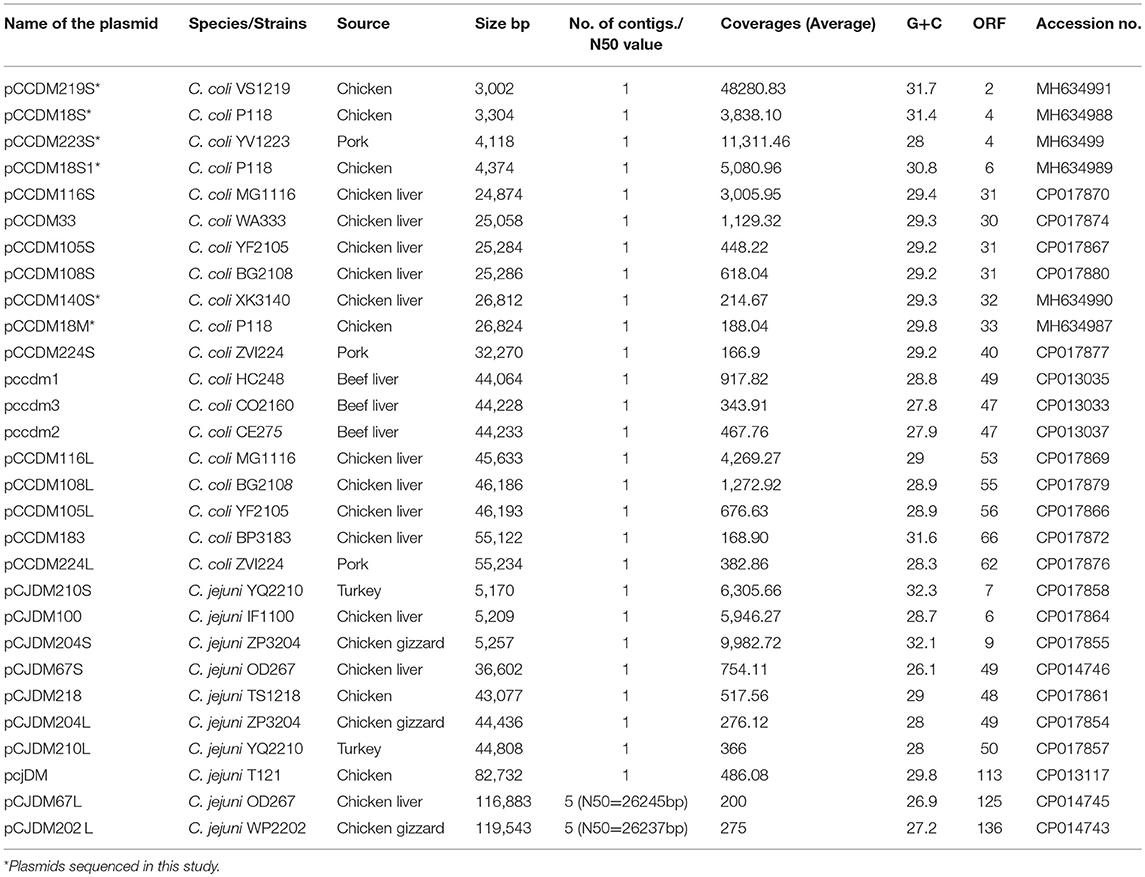
Table 1. Details of the plasmids used in this study which were isolated and sequenced in our laboratory.
Plasmid Isolation and Sequencing
Whole genomic DNA and plasmid isolation from Campylobacter strains, sequencing in Illumina Miseq platform and sequence assembly process in CLC workbench version 7.5.1 have been described previously (Marasini and Fakhr, 2016a,b,c, 2017a,b,c). Briefly, whole genome DNA isolation was carried out according to manufacturer's protocol with DNeasy Blood and Tissue kit (Qiagen Inc, Valencia, CA, United States) from cells grown micro-aerobically for 72 h in Mueller Hinton (MH) broth with 5% blood at 42°C. The Qiagen plasmid midi kit (Qiagen Inc, Valencia, CA, United States) was used for plasmid isolation according to manufacturer's protocol. DNA quantification was done with a Qubit 2.0 fluorimeter using high sensitivity ds DNA assay kit (Life Technologies, CA, United States) and library preparation for sequencing was completed using a Nextera XT sample preparation kit (Illumina Inc, CA, United States) as per manufacturer's instructions. Sequencing was done on Illumina MiSeq platform using Illumina MiSeq V2 reagent kit 2×150 cycles (Illumina Inc, CA, United States). Sequence assembly was performed using CLC Genomics Workbench version 7.5.1. Plasmid sequences with several contigs were joined and made into a single contig using contig vs. contig alignment. Joints for the contigs were confirmed by PCR and Sanger sequencing.
Plasmid sequences have been deposited in Genbank (Table 1), and announced briefly as part of whole genome sequences (Marasini and Fakhr, 2016a,b,c, 2017a,b,c). Details of all plasmids isolated from our laboratory including their Genbank accession number, number of contigs, N50 and coverages are listed in Table 1. All plasmid sequences submitted to GenBank were annotated by the NCBI Prokaryotic Genome Annotation Pipeline. The RAST online tool (http://rast.nmpdr.org/rast.cgi) (Overbeek et al., 2014) was used to annotate all plasmids evaluated in this study. Circular plasmid renderings were constructed in CLC Genomics Workbench version 7.5.1.
Phylogenetic and Genomic Analysis
Pangenomic analysis of all plasmids from our laboratory was used to group plasmids in this study according to presence of different genes. Core genome and pangenome analysis for each group of plasmids from our laboratory including similar plasmids from GenBank was carried out using the GView server (https://server.gview.ca/). In addition to our 29 plasmid sequences, all available plasmid sequences of Campylobacter species were included to study the phylogenetic relatedness and possible transmission and origin of lineages of these plasmids. A total of 134 plasmid sequences of Campylobacter species (03/28/2018) from GenBank including one plasmid sequence of Helicobacter pullorum (plasmid 229336_12) were aligned. In GView server, blast analysis (nucleotide) was carried out using GenBank files of plasmid sequences with e-value (<1e-10), alignment length cutoff value (100) and percent identity cutoff value (80). For phylogenetic analysis, sequence alignment was done using the online version of MAFFT version 7 (https://mafft.cbrc.jp/alignment/server/) (Kuraku et al., 2013). Because the resulting alignment exhibited regions of non-overlap for various plasmids, a Maximum Parsimony (MP), character-based approach to phylogenetic analysis was used (i.e., neither distance-matrix methods nor nucleotide substitution models can be applied when extensive non-overlap exists). PAUP (Swofford, 2002) and MEGA 6 (Tamura et al., 2013) were used for phylogenetic construction by MP. Relative branch support was assessed using the bootstrap from 1,000 replicates. For comparison and validation of phylogenetic relatedness of plasmids inferred from MP tree, we also performed NeighborNet analysis with SplitsTree4 (Huson and Bryant, 2006).
Results
Molecular Charcterization of the Sequenced Plasmids
A total of 29 plasmids were fully sequenced using the Illumina MiSeq desktop sequencer. A total of 19 plasmids from Campylobacter coli and 10 plasmids from C. jejuni were sequenced. The sizes of circular plasmids ranged from 3,002 to 119,543 bp. Based on pangenomic analysis and types of genes present, we categorized plasmids into four different groups (Figure 1). These groups include (1) type-1 plasmids (pTet plasmids) with tetO gene, (2) type-2 plasmids commonly found in C. coli strains, (3) type-3 plasmids (pVir plasmids) and (4) type-4 plasmids (plasmids < 6000 bp). All plasmids from our study are listed in Table 1 and similar plasmids found in GenBank for each group after blast analysis are listed in Table 2.
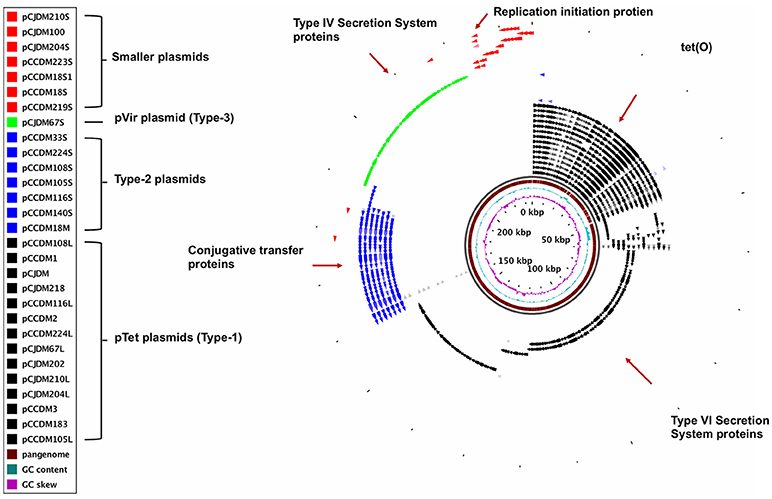
Figure 1. Different types of plasmids identified in our study. Circular Figure represents the pangenome analysis for all plasmid sequences from our laboratory. Individual slot (circle) in the figure represent one plasmid sequence. Pangenome analysis for all plasmid sequences was completed with GView server.
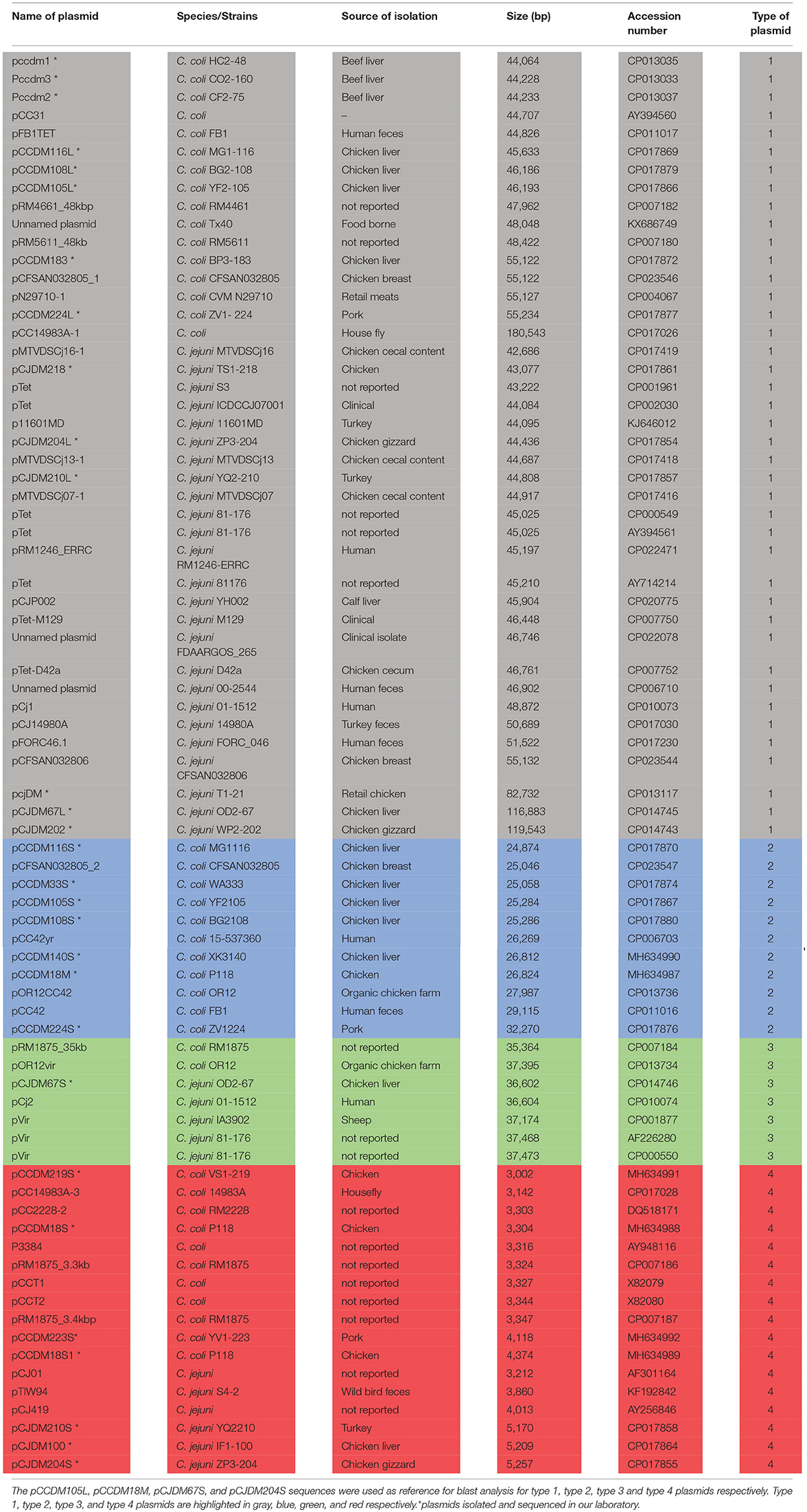
Table 2. List of all plasmids found in C. jejuni and C. coli strains from our laboratory and GenBank used for core genome and pangenome analysis.
Type-1: pTet Plasmids
The most prevalent plasmid type in C. jejuni and C. coli strains was Type 1 (pTet). Of the 29 plasmids that were isolated and sequenced, 14 were pTet plasmids (Figure 1, Table 2). Plasmid pCCDM105L served as as an examplar for all pTet plasmids and also was used as reference for core genome and pangeome analysis (Figures 2A–D). Core genome analysis among pTet plasmids isolated from our laboratory showed various genes including genes for the Type IV secretion system (virB2, virB4, virB5, virB6, virB7, virB8, virB9, virB10, and virB11 genes) as core genome (Table 3, Figure 2D, Supplementary Table 1). The core genome among pTet plasmids from our laboratory is summarized in Table 3. However, only the gene for TetO was found as core genome for all pTet plasmids of C. jejuni and C. coli from Genbank (including our 14 pTet plasmids) (Figure 2C, Supplementary Table 2). Pangenome analysis showed that most pTet plasmids share similar genomic composition and size, however, a few were determined to be megaplasmid due to the presence of extra DNA length that included some genes (Figure 2B, Supplementary Table 3). Extra Mu-like prophage genes are found to be inserted in the pcjDM plasmid (Marasini and Fakhr, 2016c), whereas, pCJDM67L, pCJDM202 (Marasini and Fakhr, 2016a) and pCC14983A-1 (from Genbank) harbor extra genes including several associated with the Type VI secretion system.
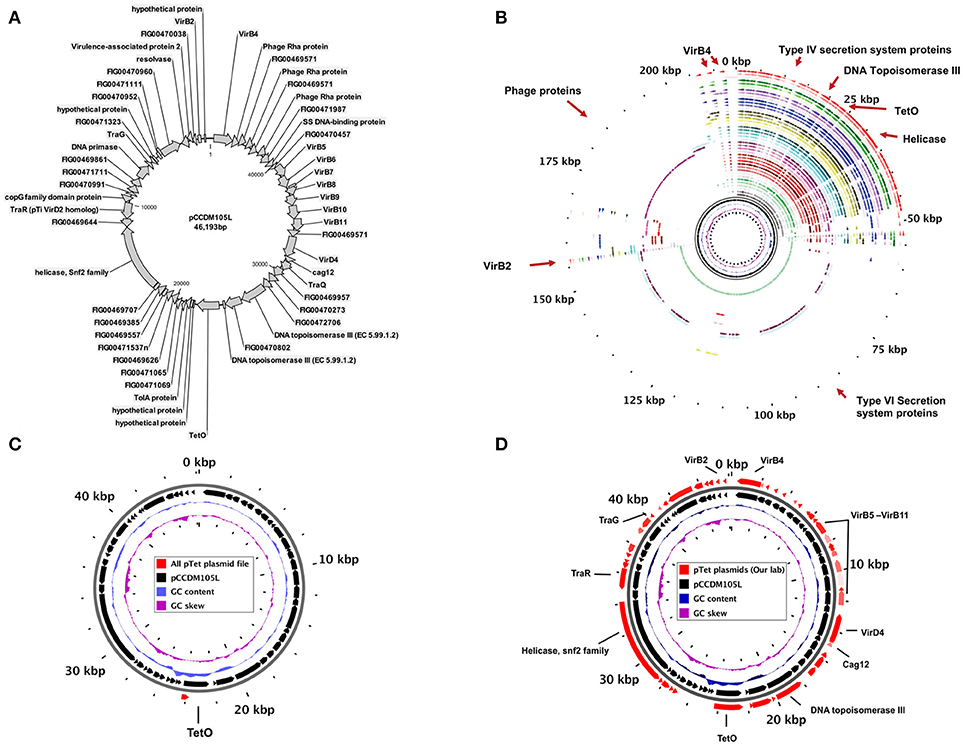
Figure 2. (A) Circular map of pTet (type-1) plasmid (pCCDM105L) showing the presence of various genes, (B) pangenome of pTet plasmids avialable in Genbank (incuding all pTet plasmids from our laboratory), (C) core genome for all pTet plasmids (red arrows in the outer circle indicate the core genome of all plasmid sequences used in the study), and (D) core genome among pTet plasmids isolated and sequenced from our laboratory.
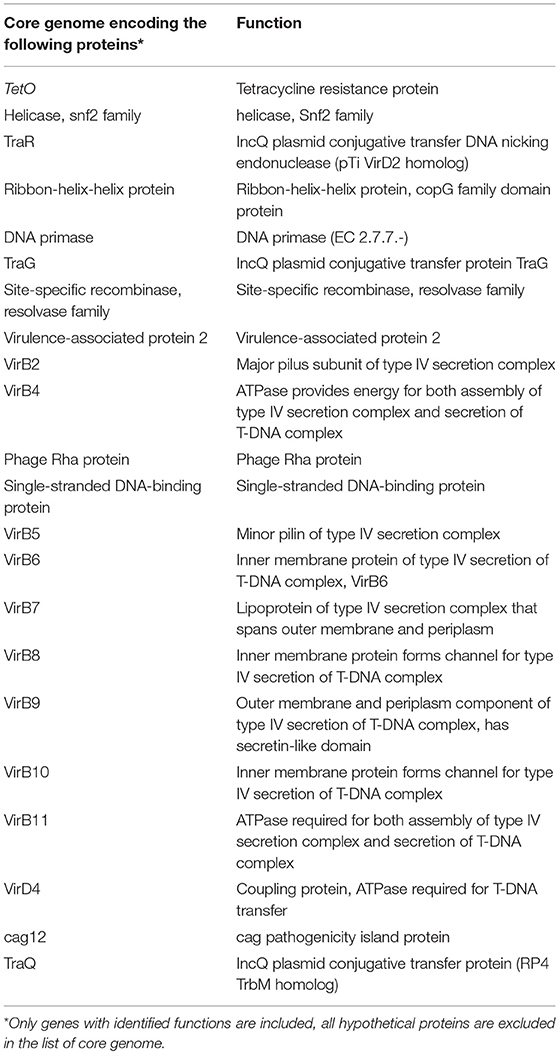
Table 3. The common genes (with identified functions only) present in all of type-1 (pTet) plasmids from our laboratory isolates (details and percentage identity in Supplementary Table 1).
Few genes responsible for virulence and antibiotic resistance were found in different plasmids (Supplementary Table 3). A gene encoding virulence-associated protein 2 (VapD) was found in all pTet plasmids from our laboratory. The protein kinase gene was present in pccdm2, pccdm3, pCJDM210L and pCJDM204L. An aminoglycoside phosphotransferase gene was present in pccdm1, pCJDM, pCCDM183, and pCCDM224L. Histidine kinase and DNA-cytosine methyltransferase were present only in pCCDM224L. Kanamycin kinase, uridine phosphorylase, spectinomycin adenyl transferase, hygromycin B-phosphorylase, pyrrolidone–carboxylase peptidase, aminoglycoside adenyltransferase and streptothiricin acetyl transferase were present in pCCDM183 (Marasini and Fakhr, 2017c). The pCJDM plasmid harbors most of the multidrug resistance genes that are also present in pCCDM183 except uridine phosphorylase and spectinomycin adenyl transferase (Marasini and Fakhr, 2016c). All genes present in pTet plasmids and percentage similarity to other plasmids are listed in Supplementary Table 3.
Type-2: Campylobacter coli Specific Plasmids
The type-2 plasmids are -the second-most prevalent group from our study (Figure 1, Table 2). These plasmids were found only in C. coli strains and were not found in any of the C. jejuni strains screened in our study. Type-2 plasmids range from 24 to 32 kb in size. Type-2 plasmids from our laboratory and similar plasmid sequences from GenBank are listed in Table 2. The plasmid sequence for pCCDM18M was used as reference for Blast, core genome and pangenomic analyses (Figures 3A–C, Supplementary Tables 4, 5). Results from core genome analysis among type-2 plasmids and similar plasmids from GenBank are presented in Table 4 (Figure 3B). A number of trb genes responsible for conjugative transfer were identified in these plasmids. A larger percentage of genes were conserved among the type 2 plasmids as compared to the pTet plasmids. In addition to these transfer genes, virD4, traI, gene for single-stranded DNA binding protein and traQ were common among all type-2 plasmids (Figures 3B,C, Table 4, Supplementary Tables 4, 5). Few genomic differences were found among these plasmids (Supplementary Table 5). Meanwhile, few genes related to Type IV secretion system, virB1, putative antirepresser, phage Rha proteins and mobile element protein were detected in several plasmids of this group (Supplementary Table 5).
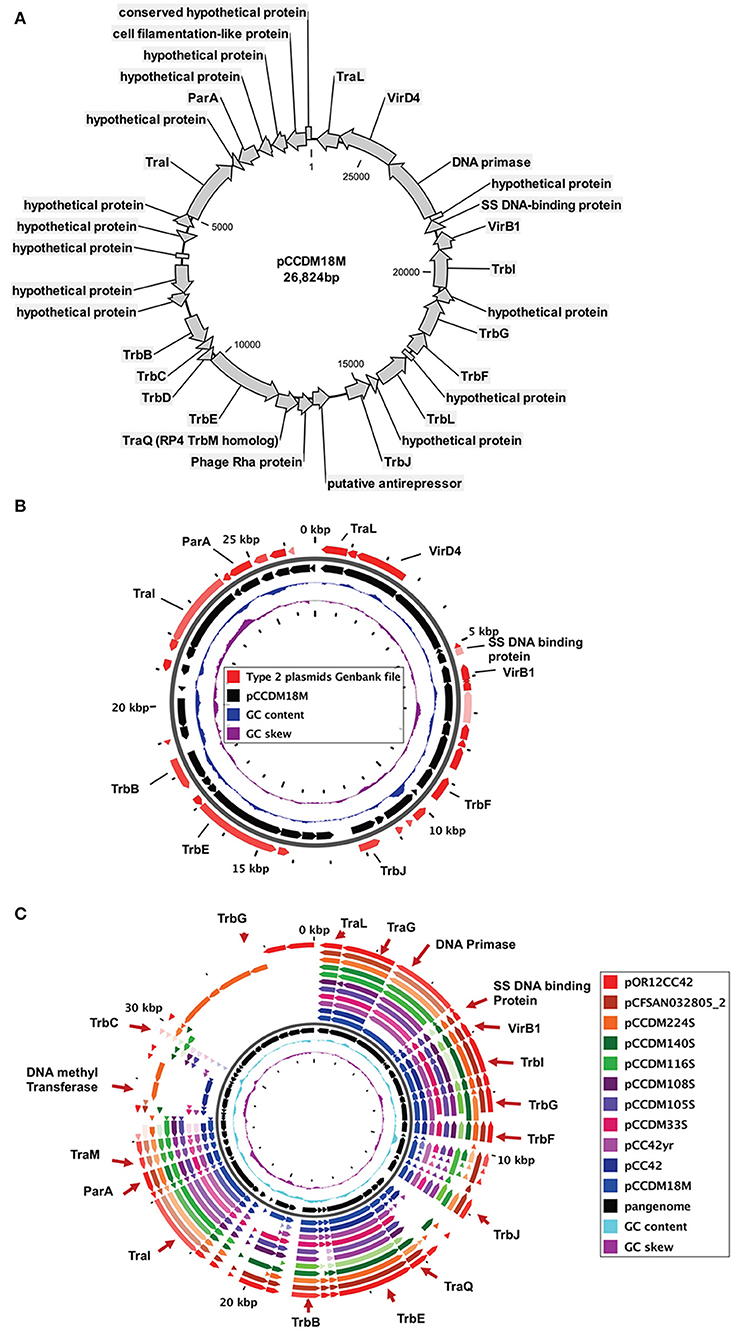
Figure 3. (A) Circular map of the type-2 plasmid (pCCDM18M), (B) core genome among all type-2 plasmids used in this study (Table 2, Supplementary Table 4), and (C) pangenome for all type-2 plasmids used in this study (Supplementary Table 5).
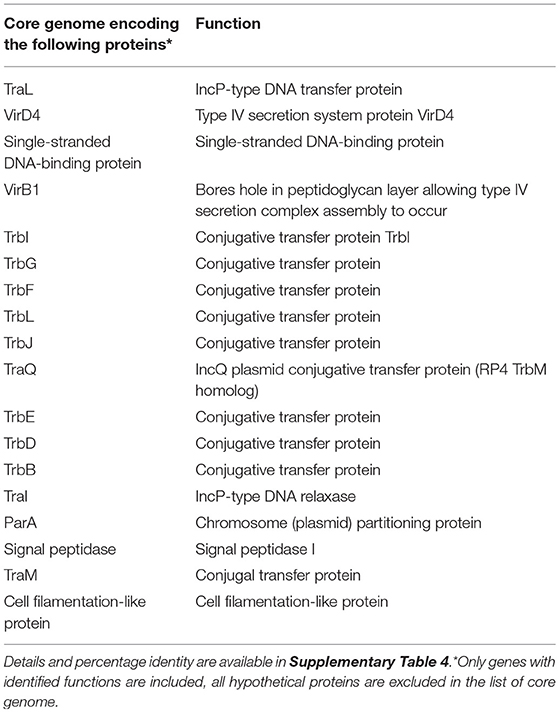
Table 4. Core genome for type-2 plasmids (including all plasmids from GenBank) presented in Table 2.
Type-3: pVir Type of Plasmid
There was only one plasmid of type-3 (pCJDM67S) among those sequenced for this project (Table 2, Figure 4A). This plasmid is similar to the pVir plasmid that was thought to be a virulence plasmid (Bacon et al., 2002). This plasmid also contains most of the hypothetical proteins observed in the pVir plasmid of Campylobacter jejuni 81-176 (Bacon et al., 2002) (Supplementary Tables 6, 7). The pCJDM67S plasmid shares ssb, genes for DNA topoisomerase, VirB10, VirB9, DNA transformation competancy protein, VirB4, TraQ, and RepE as core genome similar to other pVir plasmids (Table 5, Figures 4B,C). Details of all genes present among all pVir plasmids (pangenome) used in this study are presented in Supplementary Table 7.
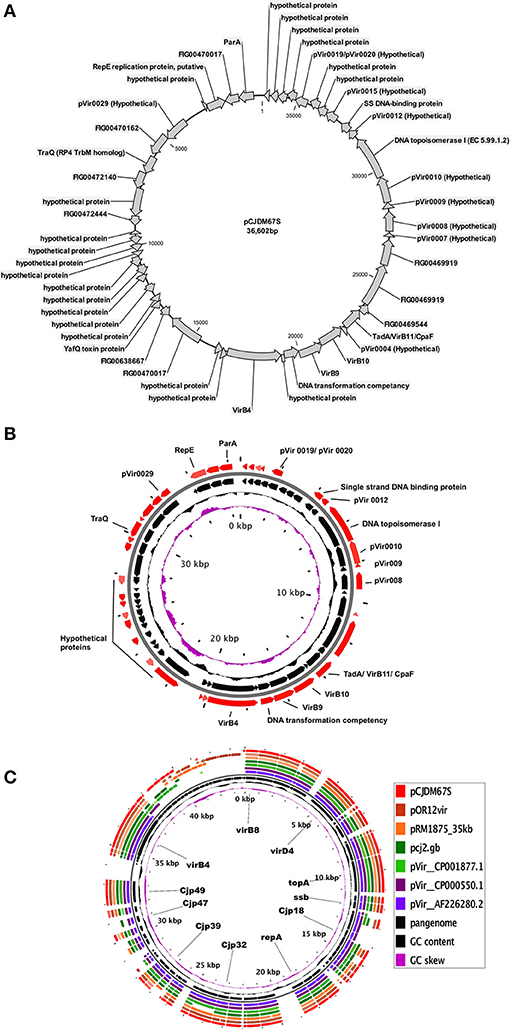
Figure 4. (A) Circular map of the plasmid, pCJDM67S, (B) core genome of pVir plasmids (Red arrows in outer circle represent core genome), and (C) pangenome of all pVir plasmids used in study.
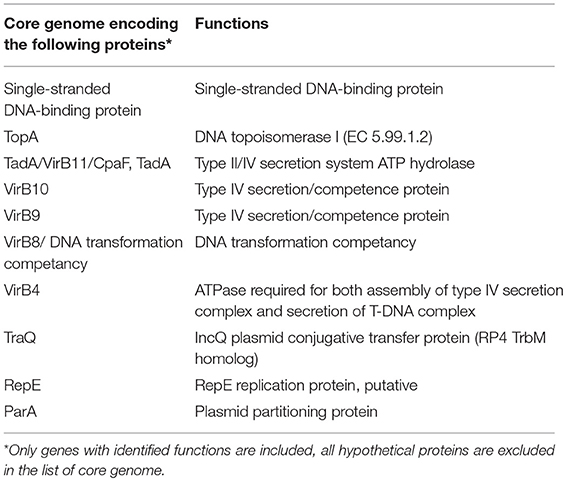
Table 5. Core genome for all pVir plasmids of C. jejuni and C. coli strains used in this study (see Table 2).
Type-4: Small Plasmids
Seven small plasmids (<6 kb) were included in our study (Table 2, Figure 1). Except for pCJDM204S and pCJDM210S, which shared some homologous genes between them, remaining small plasmids did not share similar genetic composition. Most of these plasmids contain hypothetical protein-coding genes and replication initiater genes (Figures 5A–D). Published plasmid sequences from our laboratory and some similar plasmids from GenBank share a replication initiation protein as core genome (Figure 5D, Supplementary Table 8). However, one of these sequences, pCCDM223S, only harbors hypothetical proteins (Figure 5C, Supplementary Table 9).
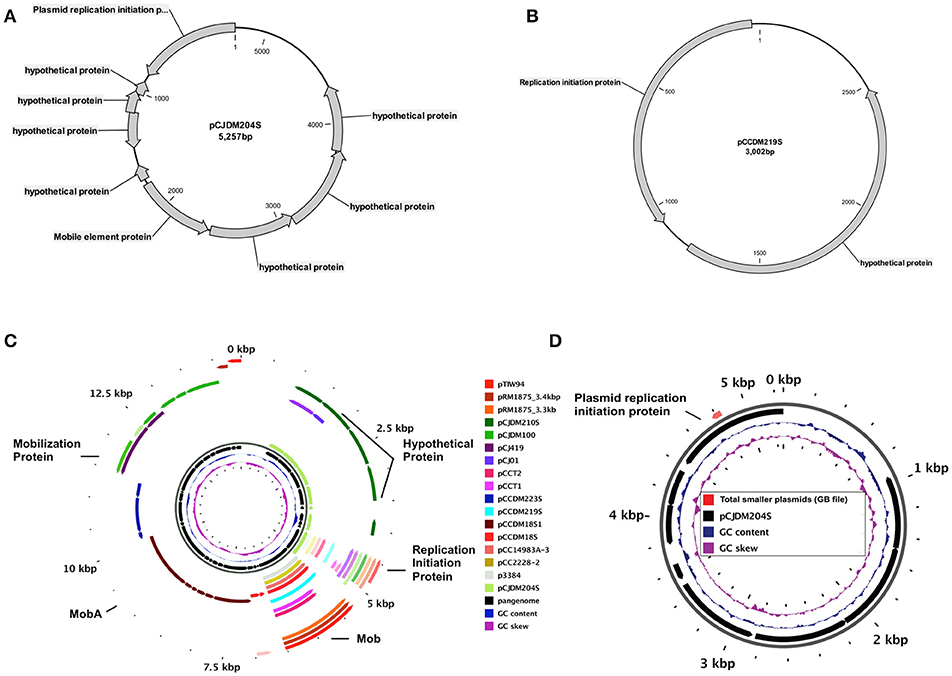
Figure 5. Circular map of the small (<6 kb) plasmids, (A) pCJDM204S, (B) pCCDM219S, (C) pangenome for all smaller plasmids used in the study and (D) core genome for all smaller plasmids of C. jejuni and C. coli strains used in this study from GenBank.
Phylogenetic Analysis
The original alignment comprised 134 plasmid sequences. Seven duplicate sequences were excluded for the final round of phylogenetic analyses. Results from the MP analysis are shown in the Figure 6. The MP tree supported a distinctive clade of pTet plasmids (type-1) and pVir plasmids (type-3) from all Campylobacter species which consisted plasmids only from C. jejuni and C. coli strains. Type-2 plasmids from C. coli strains in our study and other similar plasmids from Genbank also form a separate clade in phylogenetic tree. Although, most type-2 plasmids are from C. coli strains, two plasmids from published sequences of C. jejuni are also included in this group. A single plasmid from our laboratory (pcjdm67) is allied in a monophyletic group of type-3 plasmids (Figure 6). Five small plasmids (< 6 kb) from our study form part of a monophyletic group within a paraphyletic type-4 alliance (Figure 6). The pCCDM223S sequence forms a separate cluster with plasmid pCCON31 (from C. concisus) in the paraphyletic type-4 group (Figure 6). Numerous well-supported lineages (bootstrap values >95) are resolved by MP analysis of all plasmids from Campylobacter species. Not all plasmid sequences could be unambiguously categorized by pangenomic analysis (Figure 6). No species-specific clade was detected. Largely due to extensive regions of non-overlap between divergent plasmid sequences (i.e., missing data), relationships among pangenomic types and other major lineages are not resolved by these data. Results of the NeighborNet analysis revealed several major aggregates of plasmid sequences, all of which corresponded to robust branches on the MP tree (Supplementary Figure S1).
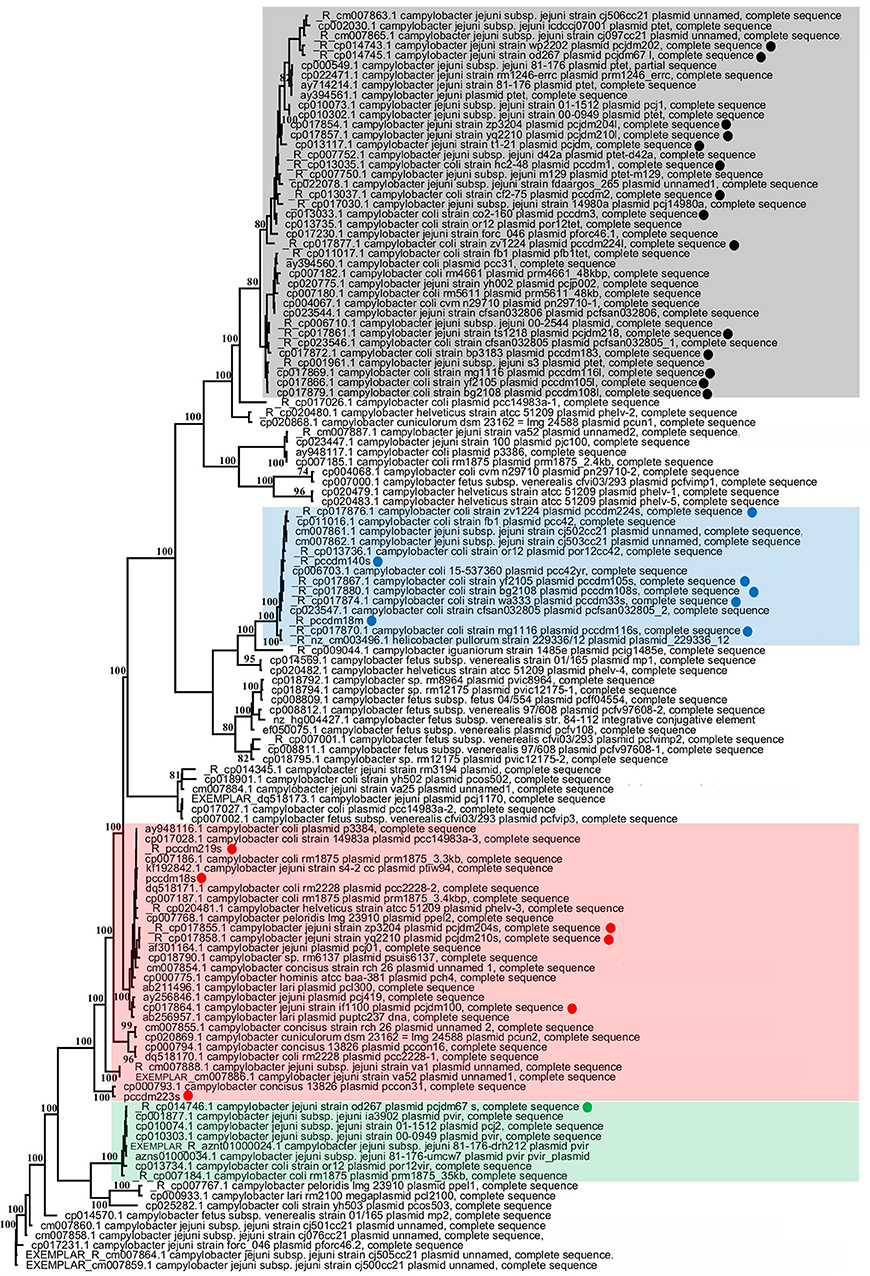
Figure 6. Maximum parsimony tree for all plasmid sequences of Campylobacter species (sequences from our laboratory are highlighted with colored circles). Categorization of plasmids from pangenomic analysis (Figure 1) are represented with shaded colors [type-1 (black), type-2 (blue), type-3 (green) and type-4 (red)] on the phylogenetic tree. Only boostrap values >70 are are mapped to the phylogenetic tree. Duplicate plasmid sequences were excluded from the analysis. The results of NeighborNet analysis for Campylobacter plasmids are illustrated in Supplementary Figure S1.
Discussion
The literature lacks much information about plasmids of C. jejuni and C. coli despite the fact that these two organisms are major causes of foodborne illness (Scallan et al., 2011). A total of 29 plasmids of different origins and from both C. jejuni and C. coli were fully sequenced for this investigation using the Illumina MiSeq technology. After complete analysis of the annotated genes by RAST (Overbeek et al., 2014), three major groups of plasmids (type 1, 2, and 3) and a few small plasmids less than 6 kb (type 4) were identified. Other foodborne pathogens, such as Salmonella spp. and E. coli, are also known to have variable plasmids as well as various types of incompatibility groups (Johnson et al., 2012; Williams et al., 2013). Thus, the diversity among plasmids from these pathogens is not unique, but confirms the assertion that plasmid diversity from even closely-related bacteria can be immense (Taylor et al., 1983; Tenover et al., 1985).
Only the gene for tetracycline resistance (tetO) is found to be in core genome among all pTet plasmids (Figure 2C). As noted previously, the tetO gene present in pTet plasmids (type-1) also shares sequence similarity with the tetM gene of Streptococcus spp., indicating the possibility of a genetic exchange between Gram-positive and Gram-negative bacteria (Taylor, 1986). Although the tetO gene found in pTet plasmids from Campylobacter is regarded as homologous to tetracycline resistance genes from other bacteria, the genetic composition of Campylobacter plasmids shows little similarity to plasmids of other bacteria. The presence of the tetO gene in both the chromosome and the plasmids of C. jejuni and C. coli indicates that the gene was either present in the chromosome and was later transferred with the integrated plasmids, or it might have reached the chromosome following acquisition of an integrated plasmid (Pratt and Korolik, 2005; Crespo et al., 2012). The high prevalence of pTet plasmids in Campylobacter strains from our study is similar to previous reports of clinical isolates in Germany (Schmidt-Ott et al., 2005). The presence of pTet (type-1) and pVir (type-3) in Campylobacter was also discussed in the previous investigation (Schmidt-Ott et al., 2005). We concur with Schmidt-Ott et al. (2005) that pVir plasmids are less prevalent than pTet plasmids in Campylobacter strains.
The pTet plasmids harbor important genes responsible for conjugation and virulence, exemplified by the Type IV secretion system (Bacon et al., 2000). The Type IV secretion system was reported in chromosomes of Helicobacter pylori (Fernandez-Gonzalez and Backert, 2014) and was conserved in the plasmids and various genomic islands in Campylobacter fetus (Graaf–van Bloois et al., 2016). Many hypothetical proteins of unknown function were observed in several previously-characterized plasmids (Batchelor et al., 2004) and also in plasmids sequenced for this investigation. Some of the genes responsible for conjugation are similar to genes from Actinobacillus actinomycetemcomitants (Batchelor et al., 2004), which might indicate transfer of conjugative genes between nonrelated microbes. Some of the pTet plasmids (pcjDM, pCCDM183, pccdm1, and pCCDM224L) were found to possess the aminoglycoside phosphotransferase genes. These pTet plasmids are all greater than 48 kb in size except pccdm1 which is only 44 kb in size. Some plasmids (i.e., pcjDM and pCCDM183) contained multidrug resistance genes such as aminoglycoside adenyl transferase, streptothiricin- and hygromycin-resistant genes. In addition, the pCCDM183 plasmid sequence also contained genes for kanamycin kinase and spectinomycin o-adenyl transferase. The presence of aminoglycoside resistance genes in Campylobacter strains was also reported in previous studies (Tenover et al., 1992; Chen et al., 2013). Megaplasmids of more than 80 kb are present in the pTet plasmids (type-1) group (Marasini and Fakhr, 2016a,c; Miller et al., 2016). In addition to the common genes among pTet plasmids (Table 3), the megaplasmids were shown to have an inserted segment of bacteriophage genes or other types of mobile genetic components (Gunther et al., 2016; Marasini and Fakhr, 2016c). Some of these megaplasmids also contained the complete Type VI secretion system with all 14 core genes present (Marasini and Fakhr, 2016a). The fact that 14/29 plasmids sequenced in our laboratory were pTet plasmids (Table 2) is not surprising since we previously reported that tetracycline resistance was prevalent among Campylobacter jejuni and Campylobacter coli strains isolated from various retail meats (Noormohamed and Fakhr, 2012, 2013, 2014). Functional analysis of the virulence and antimicrobial resistance genes present on these plasmids is worth investigating and may shed some light on the role of these genes in conferring the corresponding phenotypes.
The type-2 plasmids, which ranged in size from 24 kb to 32 kb, were similar to few others deposited in the GenBank. This plasmid group primarily consists of plasmids from C. coli strains. However, two plasmids from C. jejuni strains are also found to be allied in this group (Figure 6). A plasmid present in Helicobacter pullorum (i.e., plasmid 229336_12) is a close ally of the type-2 plasmids (Figure 6). Most of the predicted genes in these plasmids are common to all plasmids in this group (type-2) except for a few hypothetical proteins. The core genome for type-2 plasmids included genes for conjugative transfer along with type IV secretion system genes such as virD4 and virB1(Table 4). Most of the conjugative transfer genes present in these plasmids were different from the Type IV conjugative transfer genes in other C. jejuni and C. coli plasmids (type-1 and type-3). The similarity between type-2 plasmids from C. jejuni and C. coli strains and the 229336_12 plasmid (H. pullorum) might indicate a possible route of transmission and genetic interchangeability of these plasmids between species. The pCCDM67S plasmid from our study is similar to a pVir type plasmid, previously studied by Bacon et al. (2002). The pCCDM67S plasmid also contains orthologs of the Type IV secretion system found in Helicobacter pylori (Bacon et al., 2000).
In addition to types 1-3, we characterized other small cryptic plasmids (type-4) that share similar genomic composition and arrangements with previously-characterized plasmids of diverse sources (Jesse et al., 2006; Miller et al., 2007). Most of these plasmids contain the replication initiator protein and some unknown hypothetical proteins. Some of these plasmids also contain genes coding for Mob proteins.
The phylogenetic analysis clearly shows numerous, well-resolved lineages comprised of complete sequences for all Campylobacter plasmids reported to date (Figure 6, Supplementary Figure S1). The branching pattern of the phylogenetic trees supports our categorization of Campylobacter plasmids according to pangenomic analysis for type 1, 2, and 3 plasmids. In MP tree, the most prevalent pTet plasmids (type-1) were all grouped in one lineage. Similarly, type-2 and type-3 (pVir) plasmids formed distinctive clades with similar plasmids from Genbank. Type 1 (pTet), type-2, and type-3 (pVir) plasmid groups consist of plasmid sequences from C. jejuni/C. coli strains. The small (<6 kb) plasmid sequences from C. jejuni/C. coli strains cluster with plasmids from other Campylobacter species. One plasmid cluster including plasmid mp1 (CP014569.1) consists of plasmids from mostly C. fetus and non-jejuni/coli species of Campylobacter. This cluster is found near type-2 plasmids. Since we have very little knowledge of the distribution of these Campylobacter plasmids, we used Maximum Parsimony for the analysis of the plasmid sequences. In a previous study done by (Crespo et al., 2016), similar types of phylogenetic relationships were observed where the majority of plasmids with tetO genes were allied in one cluster and some smaller plasmids were allied in another cluster. Results of NeighborNet analysis indicate that plasmids found in Campylobacter species likely have a convoluted evolutionary history (Supplementary Figure S1). Nonethless, there is a 1:1 correspondence between the network (Supplementary Figure S1) and the tree from MP analysis (Figure 6) regarding major groupings of type 1, type 2 and type 3 plasmids (Supplementary Figures S1B,D,F). The root also shows correspondence between the two analyses. A portion of the type 4 group (Figure 6) forms a loose cluster in the network analysis (Supplementary Figure S1E). The type 4 group is a non-monophyletic assemblage in the MP analysis, too. This indicates that type 4 is either the most diverse plasmid type or may be comprised of additional, unrecognized types. We can simply state that the well-resolved portions of the phylogeny provide a reasonable inference for relationships among plasmids.
Most of the isolated and sequenced plasmids are associated with isolates of C. jejuni and C. coli. This observation is consistent with the fact that most clinical cases of Campylobacter infection are associated with C. jejuni and C. coli strains (Acheson and Allos, 2001; Gillespie et al., 2002). The absence of any species-specific plasmid clades indicates intra-species dissemination of plasmids among Campylobacter species. Several divergent lineages are present in our analyses (Figure 6, Supplementary Figure S1) and these may be representatives of larger, but under-sampled plasmid lineages. Thus, the results of this study indicate that additional sampling will be needed to more fully understand the evolution and transmission of Campylobacter plasmids.
Author Contributions
MF conceived the research idea and design. DM and AK performed the experimental procedures. DM, AK, and MB performed the phylogenetic analysis. DM, AK, MB, and MF prepared the manuscript.
Conflict of Interest Statement
The authors declare that the research was conducted in the absence of any commercial or financial relationships that could be construed as a potential conflict of interest.
Acknowledgments
We would like to acknowledge financial support from the Research Office of The University of Tulsa (Tulsa, OK, USA) for awarding DM a student research grant.
Supplementary Material
The Supplementary Material for this article can be found online at: https://www.frontiersin.org/articles/10.3389/fmicb.2018.02167/full#supplementary-material
References
Acheson, D., and Allos, B. M. (2001). Campylobacter jejuni infections: update on emerging issues and trends. Clin. Infect. Dis. 32, 1201–1206. doi: 10.1086/319760
Bacon, D. J., Alm, R. A., Burr, D. H., Hu, L., Kopecko, D. J., Ewing, C. P., et al. (2000). Involvement of a plasmid in virulence of Campylobacter jejuni 81-176. Infect. Immun. 68, 4384–4390. doi: 10.1128/IAI.68.8.4384-4390.2000
Bacon, D. J., Alm, R. A., Hu, L., Hickey, T. E., Ewing, C. P., Batchelor, R. A., et al. (2002). DNA sequence and mutational analyses of the pVir plasmid of Campylobacter jejuni 81-176. Infect. Immun. 70, 6242–6250. doi: 10.1128/IAI.70.11.6242-6250.2002
Batchelor, R. A., Pearson, B. M., Friis, L. M., Guerry, P., and Wells, J. M. (2004). Nucleotide sequences and comparison of two large conjugative plasmids from different Campylobacter species. Microbiology 150, 3507–3517. doi: 10.1099/mic.0.27112-0
Chen, Y., Mukherjee, S., Hoffmann, M., Kotewicz, M. L., Young, S., Abbott, J., et al. (2013). Whole-genome sequencing of gentamicin-resistant Campylobacter coli isolated from U.S. retail meats reveals novel plasmid-mediated aminoglycoside resistance genes. Antimicrob. Agents Chemother. 57, 5398–5405. doi: 10.1128/AAC.00669-13
Crespo, M. D., Altermann, E., Olson, J., Miller, W. G., Chandrashekhar, K., and Kathariou, S. (2016). Novel plasmid conferring kanamycin and tetracycline resistance in the turkey-derived Campylobacter jejuni strain 11601MD. Plasmid 86, 32–37. doi: 10.1016/j.plasmid.2016.06.001
Crespo, M. D., Olson, J. W., Altermann, E., Siletzky, R. M., and Kathariou, S. (2012). Chromosomal tet(O)-harboring regions in Campylobacter coli isolates from turkeys and swine. Appl. Environ. Microbiol. 78, 8488–8491. doi: 10.1128/AEM.02258-12
Fernandez-Gonzalez, E., and Backert, S. (2014). DNA transfer in the gastric pathogen Helicobacter pylori. J. Gastroenterol. 49, 594–604. doi: 10.1007/s00535-014-0938-y
Friis, L. M., Pin, C., Taylor, D. E., Pearson, B. M., and Wells, J. M. (2007). A role for the tet(O) plasmid in maintaining Campylobacter plasticity. Plasmid 57, 18–28. doi: 10.1016/j.plasmid.2006.06.005
Gillespie, I. A., O'Brien, S. J., Frost, J. A., Adak, G. K., Horby, P., Swan, A. V., et al. (2002). A case-case comparison of Campylobacter coli and Campylobacter jejuni infection: a tool for generating hypotheses. Emerg. Infect. Dis. 8, 937–942. doi: 10.3201/eid0809.010187
Graaf–van Bloois, L. v., Miller, W. G., Yee, E., Gorkiewicz, G., Forbes, K. J., Zomer, A. L., et al. (2016). Campylobacter fetus Subspecies contain conserved Type IV secretion systems on multiple genomic islands and plasmids. PLoS ONE11, e0152832. doi: 10.1371/journal.pone.0152832
Gunther, N. W., Reichenberger, E. R., and Bono, J. L. (2016). Complete genome sequence of UV-resistant Campylobacter jejuni RM3194, including an 81.08-Kilobase plasmid. Genome Announc. 4, e00305–e00316. doi: 10.1128/genomeA.00305-16
Hiett, K. L., Rothrock, M. J., and Seal, B. S. (2013). Characterization of the Campylobacter jejuni cryptic plasmid pTIW94 recovered from wild birds in the southeastern United States. Plasmid 70, 268–271. doi: 10.1016/j.plasmid.2013.04.004
Huson, D. H., and Bryant, D. (2006). Application of phylogenetic networks in evolutionary studies. Mol. Biol. Evol. 23, 254–267. doi: 10.1093/molbev/msj030
Jesse, T. W., Pittenger-Alley, L. G., and Englen, M. D. (2006). Sequence analysis of two cryptic plasmids from an agricultural isolate of Campylobacter coli. Plasmid 55, 64–69. doi: 10.1016/j.plasmid.2005.06.001
Johnson, T. J., Bielak, E. M., Fortini, D., Hansen, L. H., Hasman, H., Debroy, C., et al. (2012). Expansion of the IncX plasmid family for improved identification and typing of novel plasmids in drug-resistant Enterobacteriaceae. Plasmid 68, 43–50. doi: 10.1016/j.plasmid.2012.03.001
Kuraku, S., Zmasek, C. M., Nishimura, O., and Katoh, K. (2013). aLeaves facilitates on-demand exploration of metazoan gene family trees on MAFFT sequence alignment server with enhanced interactivity. Nucleic Acids Res. 41, W22–W28. doi: 10.1093/nar/gkt389
Louwen, R. P., van Belkum, A., Wagenaar, J. A., Doorduyn, Y., Achterberg, R., and Endtz, H. P. (2006). Lack of association between the presence of the pVir plasmid and bloody diarrhea in Campylobacter jejuni enteritis. J. Clin. Microbiol. 44, 1867–1868. doi: 10.1128/JCM.44.5.1867-1868.2006
Marasini, D. (2016). Molecular characterization of megaplasmids in Campylobacter jejuni and Campylobacter coli isolated from retail meats. Doctoral dissertation, Retrieved from ProQuest, The University of Tulsa (10249959).
Marasini, D., and Fakhr, M. (2014). Exploring PFGE for detecting large plasmids in Campylobacter jejuni and Campylobacter coli isolated from various retail meats. Pathogens 3, 833–844. doi: 10.3390/pathogens3040833
Marasini, D., and Fakhr, M. K. (2016a). Complete genome sequences of Campylobacter jejuni strains OD267 and WP2202 isolated from retail chicken livers and gizzards reveal the presence of novel 116-kilobase and 119-kilobase megaplasmids with Type VI secretion systems. Genome Announc. 4, e01060–e01016. doi: 10.1128/genomeA.01060-16
Marasini, D., and Fakhr, M. K. (2016b). Complete genome sequences of the plasmid-bearing Campylobacter coli strains HC2-48, CF2-75, and CO2-160 isolated from retail beef liver. Genome Announc. 4, e01004–e01016. doi: 10.1128/genomeA.01004-16
Marasini, D., and Fakhr, M. K. (2016c). Whole-genome sequencing of a Campylobacter jejuni strain isolated from retail chicken meat reveals the presence of a megaplasmid with mu-like prophage and multidrug resistance genes. Genome Announc. 4, e00460–e00416. doi: 10.1128/genomeA.00460-16
Marasini, D., and Fakhr, M. K. (2017a). Complete genome sequences of Campylobacter jejuni strains isolated from retail chicken and chicken gizzards. Genome Announc. 5, e01351–e01317. doi: 10.1128/genomeA.01351-17
Marasini, D., and Fakhr, M. K. (2017b). Complete genome sequences of plasmid-bearing Campylobacter coli and Campylobacter jejuni strains isolated from retail chicken liver. Genome Announc. 5, e01350–e01317. doi: 10.1128/genomeA.01350-17
Marasini, D., and Fakhr, M. K. (2017c). Complete genome sequences of plasmid-bearing multidrug-resistant Campylobacter jejuni and Campylobacter coli strains with type VI secretion systems, isolated from retail turkey and pork. Genome Announc. 5. e01360–e01317. doi: 10.1128/genomeA.01360-17
Miller, W. G., Heath, S., and Mandrell, R. E. (2007). Cryptic plasmids isolated from Campylobacter strains represent multiple, novel incompatibility groups. Plasmid 57, 108–117. doi: 10.1016/j.plasmid.2006.08.005
Miller, W. G., Huynh, S., Parker, C. T., Niedermeyer, J. A., and Kathariou, S. (2016). Complete genome sequences of multidrug-resistant Campylobacter jejuni strain 14980A (turkey feces) and Campylobacter coli strain 14983A (housefly from a turkey farm), harboring a novel gentamicin resistance mobile element. Genome Announc. 4, e01175–e01116. doi: 10.1128/genomeA.01175-16
Noormohamed, A., and Fakhr, M. K. (2012). Incidence and antimicrobial resistance profiling of Campylobacter in retail chicken livers and gizzards. Foodborne Pathog. Dis. 9, 617–624. doi: 10.1089/fpd.2011.1074
Noormohamed, A., and Fakhr, M. K. (2013). A higher prevalence rate of Campylobacter in retail beef livers compared to other beef and pork meat cuts. Int. J. Environ. Res. Public Health 10, 2058–2068. doi: 10.3390/ijerph10052058
Noormohamed, A., and Fakhr, M. K. (2014). Prevalence and antimicrobial susceptibility of Campylobacter spp. in Oklahoma conventional and organic retail poultry. Open Microbiol. J. 8, 130–137. doi: 10.2174/1874285801408010130
Overbeek, R., Olson, R., Pusch, G. D., Olsen, G. J., Davis, J. J., Disz, T., et al. (2014). The SEED and the Rapid Annotation of microbial genomes using Subsystems Technology (RAST). Nucleic Acids Res. 42, D206–D214. doi: 10.1093/nar/gkt1226
Pratt, A., and Korolik, V. (2005). Tetracycline resistance of Australian Campylobacter jejuni and Campylobacter coli isolates. J. Antimicrob. Chemother. 55, 452–460. doi: 10.1093/jac/dki040
Scallan, E., Hoekstra, R. M., Angulo, F. J., Tauxe, R. V., Widdowson, M. A., Roy, S. L., et al. (2011). Foodborne illness acquired in the United States–major pathogens. Emerg. Infect. Dis. 17, 7–15. doi: 10.3201/eid1701.P11101
Schmidt-Ott, R., Pohl, S., Burghard, S., Weig, M., and Gross, U. (2005). Identification and characterization of a major subgroup of conjugative Campylobacter jejuni plasmids. J. Infect. 50, 12–21. doi: 10.1016/j.jinf.2004.02.013
Tamura, K., Stecher, G., Peterson, D., Filipski, A., and Kumar, S. (2013). MEGA6: Molecular Evolutionary Genetics Analysis Version 6.0. Mol. Biol. Evol. 30, 2725–2729. doi: 10.1093/molbev/mst197
Taylor, D. E. (1986). Plasmid-mediated tetracycline resistance in Campylobacter jejuni: expression in Escherichia coli and identification of homology with streptococcal class M determinant. J. Bacteriol. 165, 1037–1039. doi: 10.1128/jb.165.3.1037-1039.1986
Taylor, D. E., Garner, R. S., and Allan, B. J. (1983). Characterization of tetracycline resistance plasmids from Campylobacter jejuni and Campylobacter coli. Antimicrob. Agents Chemother. 24, 930–935. doi: 10.1128/AAC.24.6.930
Tenover, F. C., Fennell, C. L., Lee, L., and LeBlanc, D. J. (1992). Characterization of two plasmids from Campylobacter jejuni isolates that carry the aphA-7 kanamycin resistance determinant. Antimicrob. Agents Chemother. 36, 712–716. doi: 10.1128/AAC.36.4.712
Tenover, F. C., Williams, S., Gordon, K. P., Nolan, C., and Plorde, J. J. (1985). Survey of plasmids and resistance factors in Campylobacter jejuni and Campylobacter coli. Antimicrob. Agents Chemother. 27, 37–41. doi: 10.1128/AAC.27.1.37
Keywords: Campylobacter, plasmids, phylogenetic relatedness, retail meats, next generation sequencing
Citation: Marasini D, Karki AB, Buchheim MA and Fakhr MK (2018) Phylogenetic Relatedness Among Plasmids Harbored by Campylobacter jejuni and Campylobacter coli Isolated From Retail Meats. Front. Microbiol. 9:2167. doi: 10.3389/fmicb.2018.02167
Received: 25 May 2018; Accepted: 23 August 2018;
Published: 12 September 2018.
Edited by:
Learn-Han Lee, Monash University Malaysia, MalaysiaReviewed by:
Santiago Castillo Ramírez, Universidad Nacional Autónoma de México, MexicoAndrea Zuccolo, Scuola Sant'Anna di Studi Avanzati, Italy
Beatrix Stessl, Veterinärmedizinische Universität Wien, Austria
Copyright © 2018 Marasini, Karki, Buchheim and Fakhr. This is an open-access article distributed under the terms of the Creative Commons Attribution License (CC BY). The use, distribution or reproduction in other forums is permitted, provided the original author(s) and the copyright owner(s) are credited and that the original publication in this journal is cited, in accordance with accepted academic practice. No use, distribution or reproduction is permitted which does not comply with these terms.
*Correspondence: Mohamed K. Fakhr, bW9oYW1lZC1mYWtockB1dHVsc2EuZWR1
 Daya Marasini
Daya Marasini Anand B. Karki
Anand B. Karki Mark A. Buchheim
Mark A. Buchheim Mohamed K. Fakhr
Mohamed K. Fakhr